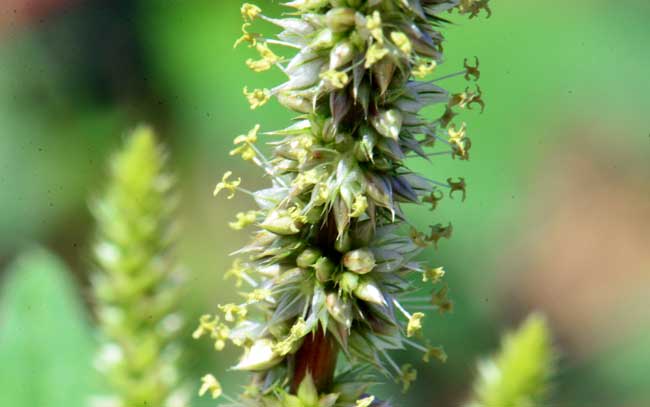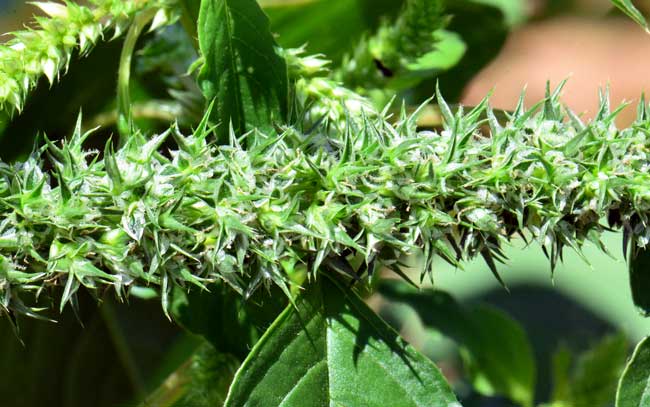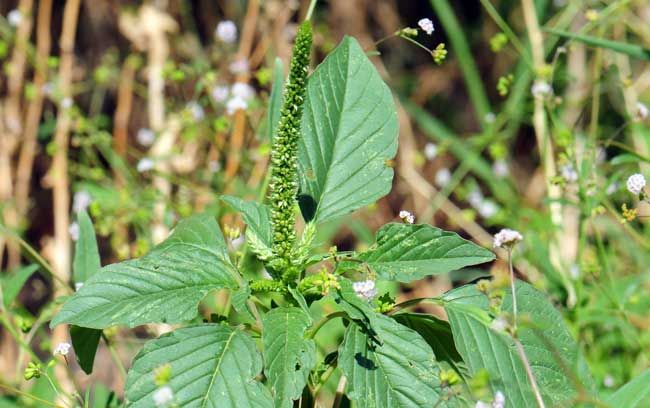Amaranthus palmeri, Carelessweed



Scientific Name: Amaranthus palmeri
Common Name: Carelessweed
Also Called: Careless Weed, Palmer Amaranth and Palmer's Amaranth and Pigweed (Spanish: Bledo, Quelite)
Family: Amaranthaceae, Pigweed Family
Synonyms: ()
Status: Native
Duration: Annual
Size: Up to 6 feet or more, usually around 3 feet.
Growth Form: Forb/herb; erect, main stem with multiple branches, glabrous with a distinctive silhouette.
Leaves: Green; alternate, shape variable lanceolate, elliptic or ovate, long petioles, blade can get up to 6 inches or more in length.
Flower Color: White or whitish-green; flowers with sepals only, sessile, densely packed in spike-like or in leaf axillaries, spine tipped bracts subtending sepals, male and female flowers (deciduous), fruit is a tiny seed-vessel that splits open along the circumference (circumscissile), seeds are red or brown.
Flowering Season: Summer and early fall.
Elevation: Below 5,500 feet.
Habitat Preferences: Lower and upper deserts in river bottoms, roadsides, fields and irrigated lands.
Recorded Range: Found in the southern parts of the United States and Baja California and northwest Mexico. Listed as an invasive weed in Ontario, Canada.
North America & US County Distribution Map for Amaranthus palmeri.
U.S. Weed Information: Amaranthus palmeri is listed in: Weeds of the United States and Canada, and Weeds of the West. Plants included here may become weedy or invasive.
Invasive/Noxious Weed Information: No USGS data available.
Wetland Indicator: Amaranthus palmeri is on the USDA 2012 National Wetland Plant List as a facultative species, i.e. the species usually occurs in non-wetlands, but may occur in wetlands.
Threatened/Endangered Information: No USGS data available.
Comments: Carelessweed or Palmer’s Amaranth, as well as many other species, was named in honor of Edward Palmer (1829–1911), a self-taught British botanist and early American archaeologist. With summer rainfall this is one of the fastest growing, and common roadside pigweeds found in Arizona below 5,500 feet. Its seeds are favored by doves, quail and other graniferous birds.
Also see in Southwest Desert Flora; Prostrate Pigweed, Amaranthus albus and Fringed Amaranth, Amaranthus fimbratus.
Carelessweed has been cultivated by used as a food source, both seeds and as a vegetable, by Native Americans throughout the United States. There are several ethno-botanical uses identified at Native American Ethnobotany, University of Michigan, Dearborn.

